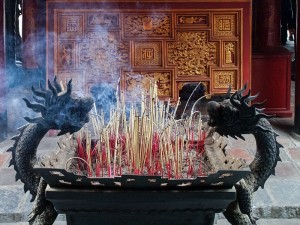For the Vietnamese, food plays a major role in funeral traditions, both for the person who has died and his or her surviving loved ones. The traditions commence with how the body is prepared for the visitors expected during the wake. Family members ceremonially cleanse the body of their loved one who has died. A clean and well-coiffed body is extremely important for the upcoming journey to the afterlife. The prevalence of the Vietnamese’s superstitious beliefs about the devil makes its first appearance because some areas of Vietnam believe it is important to place bunches of bananas on the bodies in the hopes that they will deter the devil from devouring the intestines.
This tradition serves to prevent the dead person’s departure from the world to be one with any lingering want or hunger.
When the wake occurs, the mouth of the dead person remains propped open with a chopstick, so that visitors can drop coins and grains of rice inside as they pay their respects. This tradition prevents the dead person’s departure from the world to be one with any lingering want or hunger.
During the wake, the fear of the devil reappears when grieving loved ones place bowls of rice they have brought on top of the coffin.
During the wake, the fear of the devil reappears when grieving loved ones place bowls of rice they have brought on top of the coffin. This serves as a way of ensuring that the coffin will weigh too much for the devil to enter it.
After placing the body in the coffin, loved ones build an altar filled with pictures, flowers and incense. They then take turns placing food offerings for their late loved one’s soul at the altar. The standard offering consists of three bowls of rice, three cups of tea and some other distinct dishes. Those in North Vietnam, however, might choose to place a single bowl of rice, a single cup of water, a boiled egg and some joss (a type of incense) sticks in a bowl filled with uncooked rice and surrounded by lit candles. This difference most likely has to do with those who practice Buddhism in Vietnam, since joss sticks play an important role in Buddhist ceremonies. The offering ceremony must occur three times a day during mourning.
Food offerings, especially the bringing of rice, to the altar officially stop after 49 days of mourning. After 100 days of mourning, the family of the person who has died celebrates “tot khoc,” which means “the end of tears.” The Vietnamese hold special dinners to commemorate the 49th and 100th days of mourning as well as the first anniversary of their beloved family members’ deaths. One popular dish during these special meals would be bun bo, a hearty beef and noodle soup, perhaps to sustain families for futures without their loved ones who have died.

 Vietnamese Funeral Food Customs and Superstitions
Vietnamese Funeral Food Customs and Superstitions





 “Help Me, Helen”
“Help Me, Helen”
 Recovering Cremation Remains After the Los Angeles Fires
Recovering Cremation Remains After the Los Angeles Fires
 “As Tears Go By” by Marianne Faithfull
“As Tears Go By” by Marianne Faithfull














